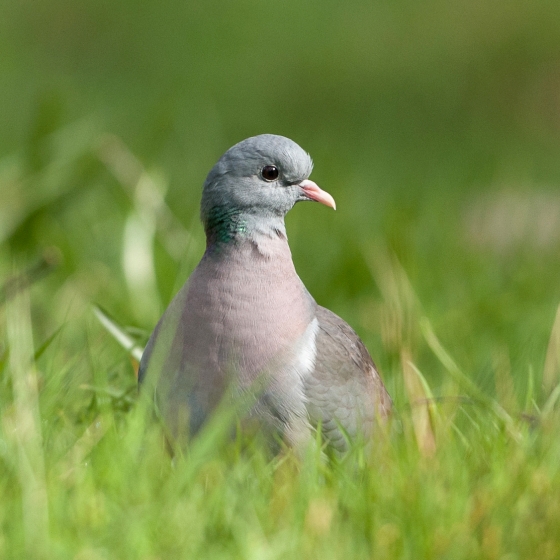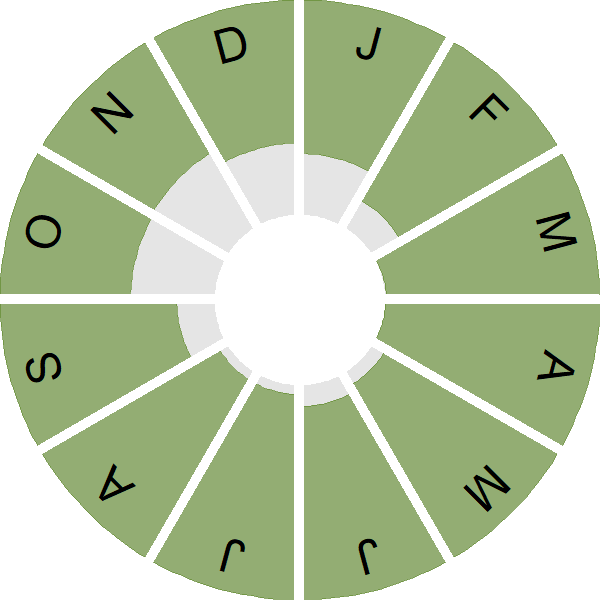Stock Dove

Introduction
The Stock Dove is an arguably underrated bird, despite being a neat and rather pretty species. Smaller than the similar-looking Woodpigeon, and lacking white in the wing, the species is often overlooked.
The Stock Dove boasts a fine blue-grey sheen to its plumage. Two neat black lines on the closed wing, and dark wing edges in flight help to distinguish it from its cousin, the Woodpigeon. Stock Doves enjoy a mixture of farmland for feeding, and woodland where they nest in holes in large old trees.
The Stock Dove is widespread across England, Wales, southern Scotland and eastern Ireland. Bird Atlas 2007-11 data show that there has been range contraction in the north and west of Britain & Ireland over the last few decades, but this has been offset by increases in breeding density in the east.
- Our Trends Explorer gives you the latest insight into how this species' population is changing.

Key Stats
Identification
ID Videos
This section features BTO training videos headlining this species, or featuring it as a potential confusion species.
Pigeons
Songs and Calls
Song:
Call:
Other:
Status and Trends
Conservation Status
Population Change
Following release from the lethal and sublethal effects of the organochlorine seed-dressings used in the 1950s and early 1960s, Stock Dove populations have increased very substantially (O'Connor & Mead 1984). Numbers appeared to level off in the early 1980s, but the trend has been generally upward since the 1990s except for a sharp drop in numbers early in the current century. The BBS map of change in relative density between 1994-96 and 2007-09 indicates that increase has been strongest in western and eastern Britain, with decreases in midland regions. An apparent initial increase in nest failure rates at the egg stage, now reversed, was not detectable in farmland habitats alone (Siriwardena et al. 2000b). Overall, nest failure rates have fallen substantially since the 1980s and there has been a major increase in the number of fledglings raised per breeding attempt. There has been an increase across Europe since 1980 (PECBMS: PECBMS 2020a>).
Distribution
Stock Doves are distributed widely across most of England in winter and summer, but are absent in both seasons from most of northwest Scotland and from northern and western Ireland. Other gaps include the uplands of northwest Wales and southern Scotland. Highest densities occur around low-altitude alluvial arable farmland and open woodland, particularly throughout much of lowland England.
Occupied 10-km squares in UK
2007/08–10/11
or view it on Bird Atlas Mapstore.
2008–11
or view it on Bird Atlas Mapstore.
European Distribution Map
Distribution Change
Range changes in Britain are small, whereas in Ireland Stock Doves have undergone a considerable and continuous range contraction over the last 40 years, shrinking into the southeast.
Change in occupied 10-km squares in the UK
from 1981–84 to 2007–11
or view it on Bird Atlas Mapstore.
from 1968–72 to 2008–11
or view it on Bird Atlas Mapstore.
Seasonality
Stock Doves are recorded throughout the year, seen on up to 10% of complete lists in spring and summer.
Weekly pattern of occurrence
The graph shows when the species is present in the UK, with taller bars indicating a higher likelihood of encountering the species in appropriate regions and habitats.

Habitats
Breeding season habitats
Relative frequency by habitat
The graph shows the habitats occupied in the breeding season, with the most utilised habitats shown at the top. Bars of similar size indicate the species is equally likely to be recorded in those habitats.

Movement
Britain & Ireland movement
Foreign locations of birds ringed or recovered in Britain & Ireland
Dots show the foreign destinations of birds ringed in Britain & Ireland, and the origins of birds ringed overseas that were subsequently recaptured, resighted or found dead in Britain & Ireland. Dot colours indicate the time of year that the species was present at the location.
- Winter (Nov-Feb)
- Spring (Mar-Apr)
- Summer (May-Jul)
- Autumn (Aug-Oct)

European movements
EuroBirdPortal uses birdwatcher's records, such as those logged in BirdTrack to map the flows of birds as they arrive and depart Europe. See maps for this species here.
The Eurasian-African Migration Atlas shows movements of individual birds ringed or recovered in Europe. See maps for this species here.
Biology
Productivity and Nesting
Nesting timing
Egg measurements
Clutch Size
Incubation
Fledging
Survival and Longevity
Survival is shown as the proportion of birds surviving from one year to the next and is derived from bird ringing data. It can also be used to estimate how long birds typically live.
View number ringed each year in the Online Ringing Report.
Lifespan
Survival of adults
Survival of juveniles
Biometrics
Wing length and body weights are from live birds (source).
Wing length
Body weight
Ring Size
Classification, names and codes
Classification and Codes
- Order: Columbiformes
- Family: Columbidae
- Scientific name: Columba oenas
- Authority: Linnaeus, 1758
- BTO 2-letter code: SD
- BTO 5-letter code: STODO
- Euring code number: 6680
Alternate species names
- Catalan: xixella
- Czech: holub doupnák
- Danish: Huldue
- Dutch: Holenduif
- Estonian: õõnetuvi
- Finnish: uuttukyyhky
- French: Pigeon colombin
- Gaelic: Calman-gorm
- German: Hohltaube
- Hungarian: kék galamb
- Icelandic: Holudúfa
- Irish: Colm Gorm
- Italian: Colombella
- Latvian: meža balodis
- Lithuanian: paprastasis uldukas
- Norwegian: Skogdue
- Polish: siniak
- Portuguese: seixa
- Slovak: holub plúžik
- Slovenian: duplar
- Spanish: Paloma zurita
- Swedish: skogsduva
- Welsh: Colomen Wyllt
Research
Causes of Change and Solutions
Causes of change
The increase since the mid 1960s may be due to two phases: an initial recovery from the high mortality caused by organochlorines, followed by increased breeding performance.
Further information on causes of change
Stock Dove is a rare example of a farmland species in long-term increase. Its increase since the mid 1960s may fall into two phases: an initial recovery from the use of organochlorines, followed by an increase in breeding performance. It is not known why breeding should have become more productive. Overall, nest failure rates have fallen substantially since the 1980s and there has been a major increase in fledglings raised per breeding attempt.
A study based on nest record cards showed that egg-stage daily failure rate differed according to farm type between 1962-75 and 1976-95: breeding performance decreased on grazing farms and increased in arable farms, but did not differ in other farm types, suggesting that different environmental factors were acting across farm types (Siriwardena et al. 2000b).
Change from hunting quarry to protected status since 1982 has not affected the species' survival rates or population size (Aebischer 1995).
Information about conservation actions
The population of the Stock Dove is currently increasing in the UK (following a large population decline as a result of widespread organochlorine usage (O'Connor & Mead 1984), and hence specific conservation action is not currently required. It is not clear why this species is increasing in contrast to many other farmland birds, although it is not restricted to farmland and also breeds in woodland and urban areas. Conservation actions targeted at declining farmland bird species which increase the availability of seeds in winter may also benefit this species.
More Evidence
More evidence from Conservation Evidence.com
Partners
Citing BirdFacts
If you wish to cite particular content in this page (e.g. a specific value) it is best to use the original sources as linked in the page. For a more general citation of the whole page please use: BTO (20XX) BirdFacts Species: profiles of birds occurring in the United Kingdom. BTO, Thetford (www.bto.org/birdfacts, accessed on xx/xx/xxxx).

